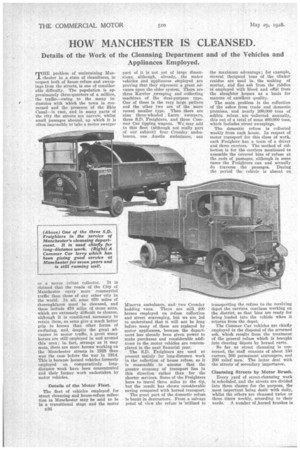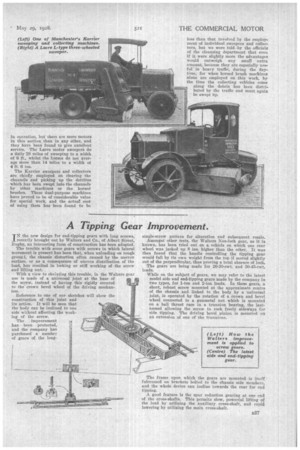HOW MANCHESTER IS CLEANSED.
Page 54

Page 55

If you've noticed an error in this article please click here to report it so we can fix it.
Details of the Work of the Cleansing Department and of the Vehicles and Appliances Employed.
THEproblem of maintaining Manchester in a state of cleanliness, in respect both of house refuse and sweepings from the streets, is one of considerable difficulty. The population is approximately three-quarters of a million, the traffic—owing to the many in / dustries with which the town is concerned and the presence of the Ship Canal—is vast, and in many. parts of the city the streets are narrow, whilst small passages abound, up which it is often impossible to take a motor sweeper or a motor refuse collector. It is
claimed that the roads of the City of Manchester carry more commercial traffic than those of any other city in the world. In all, some 670 miles of thoroughfares must be cleansed, and these include 470 miles of stone setts, which are extremely difficult to cleanse, although it is considered necessary to retain them, as setts give a much better grip to horses than other forms of surfacing, and, despite the great advances in motor traffic, a great many horses are still employed in and around this area ; in fact, strange as it may seem, there are more horses working on the Manchester streets in 1928 than was the ease before the war in 1914. This is because horsed vehicles formerly employed on comparatively longdistance work have been concentrated and their former work undertaken by motor vehicles.
Details of the Motor Fleet.
The fleet of vehicles employed for street cleansing and house-refuse collection in Manchester may be said to be in a transitional stage and the motor B38
part of it is not yet of large dimensions, although, already, the motor vehicles and appliances employed are proving that they represent a great advance upon the older system. There are three Karrier ,sweeping and collecting machines of the dual-purpose type. One of these is the very large pattern and the other two are of the more recent smaller type. Then there are nine three-wheeled . Lacre sweepers, three S.D. Freighters, and three Commer Car tipping wagons. We may add to this fleet (although not really part of our subject) four Crossley ambulances, one Austin ambulance, one
Minerva ambulance, and two Crossley bedding vans. There are still 400 horses employed on refuse collection and street scavenging, but we are led to understand that it will not be long before many of . these are replaced by motor appliances, because the department has already been given power to make purchases and considerable additions to the motor vehicles are contemplated in the next financial year.
The S.D. Freighters are used at present mainly for long-distance work in the collection of house refuse, as it is reasonable to assume that the greater economy of transport lies in this direction rather than for the shorter services. Some of the Freighters have to travel three miles to the tip, but the result has shown considerable saving compared with horsed transport.
The great part of the domestic refuse is burnt in destructors. From a salvage point of view the refuse is 'utilited to the maximum advantage; for example, several thetu,sand tons of the clinker residue are used in the making of mortar, and fine ash from the riddles is employed with blood and offal from the slaughter houses as a basis for manure of excellent quality.
The main problem is the collection of the ashes from trade and domestic premises, and nearly 200,000 tons of ttshbin refuse are .collected annually, this out of a total of some 400,000 tons, which includes street sweepings.
The domestic refuse is collected weekly from each house. In respect of motor transport for this class of work, each Freighter has a team of a driver and three carriers. The method of collection is for the carriers mentioned to assemble the covered bins of refuse at the ends of passages, although in some cases the Freighters can and actually do traverse the passages. During the period the vehicle is absent on transporting the refuse to the receiving depot the carriers continue working on the district, so that bins are ready for being loaded into the vehicle when it returns from the depot. .
The Commer Car vehicles are chiefly employed in the disposal of the screened ash, which results from the treatment of the general refuse which is brought into clearing depots by horsed carts.
So far as street cleansing is concerned, the staff consists of about 150 carters, 500 permanent scavengers, and 200 relief men. The latter deal with the streets of secondary importance.
Cleansing Streets by Motor Brush.
Every yard of street-cleansing work is scheduled, and the streets are divided into three classes for the purpose, the most important being dealt with daily, whilst the others are cleansed twice or three times weekly, according to their needs. A number of .horsed brushes is in operation, but there are more motors in this section than in any other, and they have been found to give excellent service. The Lacre motor sweepers do a daily 28 miles of sweeping to a width of 6 ft., whilst the horses do. not average more than 14 miles to a width ot 4 ft. 6 ins.
The Karrier sweepers and collectors are chiefly employed on clearing the channels and picking up the detritus which has been swept into the channels by other machines or the horsed brushes. These dual-purpose machines have proved to he of considerable value for special work, and the actual cost of using them has been found to be less than that involved by the employment of individual sweepers and collectors, but we were told -by the officials of the cleansing department that even if it were slightly more the advantages would outweigh any small extra amount, because they are especially useful in heavy traffic, during the daytime, for when horsed brush machines alone are employed on this work, by the time the collecting vehicles come along the debris has been distributed by the traffic and must again be swept up.




































































































